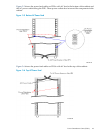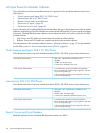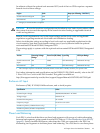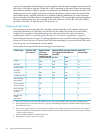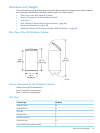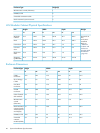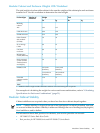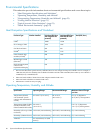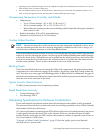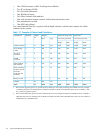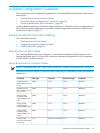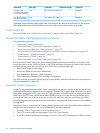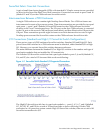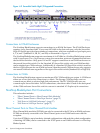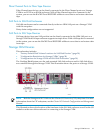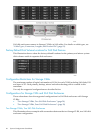
1 Operating and recommended ranges refer to the ambient air temperature and humidity measured 19.7 in. (50 cm)
from the front of the air intake cooling vents.
2 For each 1000 feet (305 m) increase in altitude above 10,000 feet (up to a maximum of 15,000 feet), subtract 1.5× F
(0.83× C) from the upper limit of the operating and recommended temperature ranges.
Nonoperating Temperature, Humidity, and Altitude
• Temperature:
— Up to 72-hour storage: - 40° to 150° F (-40° to 66° C)
— Up to 6-month storage: -20° to 131° F (-29° to 55° C)
— Reasonable rate of change with noncondensing relative humidity during the transition
from warm to cold
• Relative humidity: 10% to 80%, noncondensing
• Altitude: 0 to 40,000 feet (0 to 12,192 meters)
Cooling Airflow Direction
NOTE: Because the front door of the enclosure must be adequately ventilated to allow air to
enter the enclosure and the rear door must be adequately ventilated to allow air to escape, do
not block the ventilation apertures of a NonStop BladeSystem.
Each NonStop BladeSystem includes 10 Active Cool fans that provide high-volume, high pressure
airflow at even the slowest fan speeds. Air flow for each NonStop BladeSystem enters through
a slot in the front of the c7000 enclosure and is pulled into the interconnect bays. Ducts allow the
air to move from the front to the rear of the enclosure where it is pulled into the interconnects
and the center plenum. The air is then exhausted out the rear of the enclosure.
Blanking Panels
If the NonStop BladeSystem is not completely filled with components, the gaps between these
components can cause adverse changes in the airflow, negatively impacting cooling within the
rack. You must cover any gaps with blanking panels. In high density environments, air gaps in
the enclosure and between adjacent enclosures should be sealed to prevent recirculation of hot-air
from the rear of the enclosure to the front.
Typical Acoustic Noise Emissions
70 dB(A) (sound pressure level at operator position)
Tested Electrostatic Immunity
• Contact discharge: 8 KV
• Air discharge: 20 KV
Calculating Specifications for Enclosure Combinations
Power and thermal calculations assume that each enclosure in the cabinet is fully populated.
The power and heat load is less when enclosures are not fully populated, such as a Fibre Channel
disk module with fewer disk drives.
AC current calculations assume that one PDU delivers all power. In normal operation, the power
is split equally between the two PDUs in the cabinet. However, calculate the power load to
assume delivery from only one PDU to allow the system to continue to operate if one of the two
AC power sources or PDUs fails.
“Example of Cabinet Load Calculations” (page 52) lists the weight, power, and thermal
calculations for a system with:
Calculating Specifications for Enclosure Combinations 51



